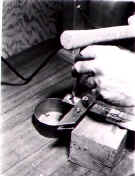Low-Cost Efficient
Reloading for Revolvers
(click on the small images to see a
larger view)
During WWII ammunition and reloading components were in short
supply for civilian use. Being in the Army during the war personal time
was a scarce commodity also. Dad came up with a way to make practice
bullets and to reload his cartridges without going to a lot of hassle. The
reloading process with these bullets is very simple. Beginning with a
fired cartridge, all you need to do is:
(1) remove the spent
primer
(2) install a fresh primer
(3) add the proper powder charge
(4)
seat the bullet with your thumb.
The cartridge is now
ready to put into the gun and fire.
These steps are easily accomplished using the Lee Loader or the Lyman 310 Tool. Either of these will work just fine. They are relatively inexpensive and require little room both for storage and to use them.
The cartridge case should be one that you have previously fired in your revolver since it will be formed to the size of your chambers. Firearms differ enough that sometimes fired cartridges will not interchange without sizing them.
All traces of the crimp should be removed. You can do this with an inside neck chamfer tool, a sharp pocket knife, or a large tapered reamer. Once this is done you should never have to size the cartridge again- as long as you keep the loads light. Since you do not neck-expand or crimp the cartridge it's life is indefinite. Dad has one .44 Magnum cartridge that he has reloaded over 1200 times (as of 1998).
Casting Using a Lyman Lead Dipper
Casting the bullet. The mold is very simple and functional. The bullets are strictly made as full-wadcutters. This cuts down on the metal used eliminating some cost, and also shortens the effective range since they are designed for a short-range practice load only
Cutting the sprue. I use an old hammer handle which works quite well.
Knocking the
bullet out of the mold
Punching the bullets out of the mold. In the photo I am using a tapered punch. It is best to use a piece of dowel rod as you won't booger the mold cavity if you slip when using a dowel.
The bullet itself is designed with a "driving band" on the front of the bullet that is basically the same diameter as the O.D. of the cartridge case. This prevents the bullet from going back into the case and additionally acts a crimp, keeping the powder charging from "pooping". The body of the bullet was tapered from the driving band to bore diameter at the base of the bullet.
No grease grooves were used as this is basically a low to medium velocity bullet and as long as they were lubed as indicated below they never gave any problems.
A cast "Slip-In" bullet ready to lubricate. All "Slip-In" bullets are full wadcutters by design. The bullets are not sized but are shot "as cast" since sizing would destroy the design of the bullet (the driving band, etc).
The bullets here are tossed into a pan containing a small amount of melted crayon -the pan is warm - and then they are shaken around until there is some crayon covering each bullet. With a nice color you can tell when the lube is over all the bullets. All you need is a fine film of lube covering the bullet. Afterwards they are poured out and let cool - about 10 minutes - and then they are ready for loading. We have also used Lee Liquid Alox which works very well.
The powder charge is measured with a dipper. This dipper was fashioned from a .22 Long Rifle cartridge and holds the proper amount of powder for the .38/.357 load. A regular powder measure can be used as can the Lee Powder Measures (which are just dippers made of plastic).
The bullet is then just slipped into the cartridge case by finger pressure and it is ready to fire.

These bullets were designed and intended only for practice and plinking. They were not for high-power or long-range loads by any means. Used as what they are designed for they provided a very efficient means of reloading cartridges for your revolver, taking very little room or time
Dad made and sold these molds for a number of years. He has not done so in a long time and they are no longer available. He held the patent on them for a long time but I believe it has expired some years ago.







